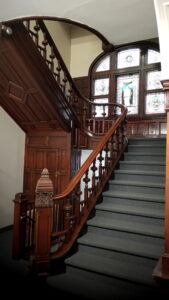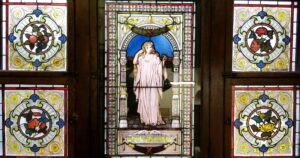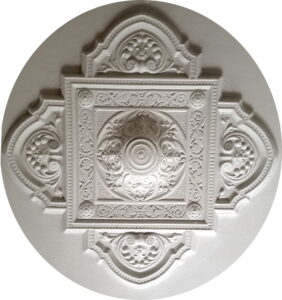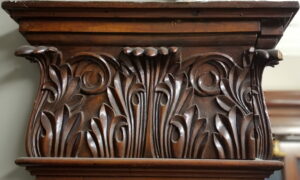The following is an article written about the Catholic Centre published in the Catholic Times, Montreal in October 1989.
It has been edited to bring it up to date.
Elegant Edwardian living, the rustle of nurses’ starched uniforms, babies crying, telephones, typewriters, computers – these are just some of the sights and sounds that have filled the rooms of the Catholic Centre on St. Marc Street during the past 100 years.

Although the house has served Montreal’s English-speaking Catholic community since 1933, it was built as a family home in 1889 by Mary Burns Johnston, the widow of a Scots merchant, and given "out of pure love and affection" to her daughter-in-law, Agnes Grant Robertson.
This dignified building at the western edge of Montreal’s Golden Square Mile was designed by the distinguished architects Hutchinson and Steele, who were also responsible for the Montreal City Hall (1874), Redpath Museum (1880) and the Erskine-American United Church (1892). The square, rather massive building is faced with a rock-faced greystone and red brick side walls. The rounded corners of the roof and walls are interesting features in an otherwise restrained use of decoration.The Johnston house was one of the first to be erected in what was then priests’ farm, a rural area owned by Les Ecclesiastiques du Seminiare de St. Sulpice de Montreal. Their terms of sale required that no businesses or quarry could exist on the land; a dwelling, of stone or brick, with a non-flammable roof (tin or copper), was to be erected within two years; the land was to be fenced at the owner’s expense; and trees were to be planted in front of the house.

Although the exterior of the house remains virtually unchanged today, the interior has been drastically remodeled to accommodate offices and meeting rooms. Unfortunately, a fire at Montreal City Hall in 1922 destroyed the records of most houses built prior to that date, making it difficult to visualize the original interior. Happily, the main wood-paneled staircase has been left untouched and a stained glass window in the pre-Raphaelite style still remains between the first and second floor.
By 1921, Agnes Johnston, with the consent of the family compact, sold the house by public auction to the Montreal Convalescent Home for the sum of $46,000.
The Convalescent Home had been founded in 1913 by a group of ladies from the Loyola Literary and Art Club with the encouragement of Fr. Edward Devine, SJ. The deed of purchase, signed on behalf of the Montreal Convalescent by E. Muriel Fraser and Mary A. Stewart, allowed the Home to move from its quarters on Overdale Avenue to the larger premises on St. Marc.
The new Home has a 33 bed capacity but by 1929 the number of patients cared for was 380 annually, all supported by donations, provincial grants and subscriptions. In 1931, having received substantial financing from private donations, the Montreal General Hospital, the Kiwanis, and the City of Montreal, land for a new building was purchased on Hudson Road. In 1933, the Montreal Convalescent Home moved into its new premises, but remained the owners of the St. Marc mansion until 1947.
At the time of the move, the house was rented to St. Martha’s Home, one of the new institutions under the recently formed Federation of Catholic Charities.

For the next 13 years, St. Martha’s Home provided emergency shelter for the unemployed or working Catholic women unable to afford accommodation. Food and clothing was provided and where possible employment found. In 1935, 170 adults and 37 babies were cared for. By 1946, the need to accommodate unwed mothers and their babies had grown drastically; the Home was caring for 676 adults and babies annually. The top floor served as a nursery for both the babies born in the house and others awaiting foster homes or adoption.
With the change of ownership in 1947 came a new era. Although the house had gone from a private residence to a public institution in 1921, structurally it had remained intact. The new owner, the Federation of Catholic Charities, who purchased the house for $38,000 planned major changes from the outset.
Founded in 1930 in response to the needs of the English-speaking Catholic community, the FCC was responsible for an annual campaign and provided financial help to a variety of volunteer associations which provided family welfare service, child care, employment, a men’s hostel and an unemployment relief committee.
Large though the Johnston house was, it could not accommodate the space requirements of this expanding organization. In 1948, an extension was built at the rear of the existing house, in 1951 and 1954, further modifications were carried out to the interior of the house; and in 1963, a five-storey addition was constructed adjoining the previous extension.

At the same time the function of the FCC was changing. With the introduction of Bill 65 in 1970, the government absorbed many of the family and childcare services. In 1974, Centraide assumed the role of principal fund-raiser for numerous community groups; as a result, the Federation of Catholic Community Services Inc. divided its operation into the Catholic Community Services (CCS) and the Foundation of Catholic Community Services Inc. (FCCS).
The Foundation now administers the assets of the erstwhile Federation, including Camp Kinkora, Camp Orelda-Marian, the buildings that house the St-Antoine 50+ Centre, and rents the Catholic Centre to a variety of organizations and individuals that serve the English-speaking Catholic Community and the greater Montreal community at large.